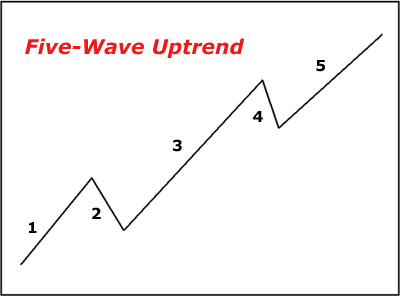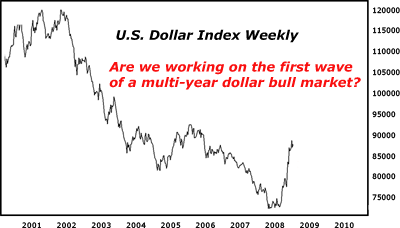U.S. Dollar Bull Market Thriving on Bearish Skeptics
Currencies / US Dollar Dec 06, 2008 - 02:21 PM GMT Jack Crooks writes: I was doing some research earlier in the week, and I came across a blog I'd never heard of written by a guy I'd never heard of on a topic that we've all most certainly heard of … the U.S. dollar.
Jack Crooks writes: I was doing some research earlier in the week, and I came across a blog I'd never heard of written by a guy I'd never heard of on a topic that we've all most certainly heard of … the U.S. dollar.
It was the same old story that's been beaten into the ground:
The U.S. dollar is doomed … the U.S. economy can't sustain its current account deficit … a U.S. economy on the brink of recession is terrible for the buck … blah, blah, blah.
Over the last several months, I've explained why the U.S. dollar is NOT DOOMED despite what have been, and will continue to be, some rotten tasting fundamentals in the United States.
You can read about my views in my past Money and Markets columns.
However, here's a different, more academic approach that builds an even stronger case for the U.S. dollar.
The first thing you need to know is this …
Markets Often Become Feedback Loops
Markets are driven by human nature and are not rational. If they were, there would be no uncertainty, no guesswork, and no market.
Because markets are driven by human perceptions and feelings, markets are completely irrational at times — sometimes longer than you may think. As John Maynard Keynes quipped, “Markets can stay irrational longer than you can stay solvent.”
Most people think trends are driven by events, the changing fundamentals. But they're not. It's the perception of these events by market participants that counts.
And depending on the time frame and market environment, investors will perceive things any number of ways. This quote sums it up …
“But what actually registers in the stock market's fluctuations, are not the events themselves, but the human reactions to these events. In short, how millions of individual men and women feel these happenings may affect their future.” — Bernard Baruch
With that in mind, here's an important point that most investors have never considered:
While the fundamentals appear to drive prices, often times it's the prices that drive the fundamentals.
Think feedback loop here.
Let me walk you through the process …
Step #1. The price of an asset falls. The reason may be triggered by the market realizing that key economic fundamentals are deteriorating, e.g. a decline in GDP or a larger-than-expected unemployment report.
Step #2. As prices fall, collateral values fall. Banks and others who lent based upon the value of collateral then must call in loans or require more collateral. This reduces available credit.
Step #3. This decline of credit adds to the deteriorating fundamentals.
Step #4. Declining fundamentals lead to more price declines.
What we're left with is a self-reinforcing process where lower prices lead to falling collateral values, further weakening the fundamentals.
This feedback loop has played out right in front of our eyes in the current crisis …
The swift decline in prices, in the credit market primarily, has drained global liquidity.
The credit market problems forced institutions to sell other “good” assets in order to generate cash.
These other “good” assets were stocks.
This in turn has triggered more selling, and so on and so forth.
And this is why, when it comes to the currency market …
The Gates to Dollar Heaven Are Guarded by Dollar Skeptics
Maybe you've heard of Ralph Nelson Elliott and his Elliott Wave Theory. Basically, this theory is a way of examining how markets move up and down in basic wave-like motions.
According to Elliott, there are five major waves of any up or down move. On a basic chart, it looks like this …
 |
Let me show you how this theory relates to the U.S. dollar right now.
Right now, the first wave of that five-wave uptrend pattern is where I think we are with the U.S. dollar …
Wave #1 of an uptrend follows the end of a five-wave downtrend. Naturally, there are plenty of skeptics of such a reversal move.
These skeptics are still stuck on the same old story, refusing to accept the potential for a major trend change.
The evidence is there — the U.S. dollar can rally. It's done so over the last several months. Take a look …
The skeptics hold on to the same old argument about why the U.S. dollar is destined to become a banana republic currency, but you may want to reconsider the premises.
 |
The argument of the skeptics goes something like this: The rally in the “doomed dollar” is only because of the fear in the market. Once this fear period passes, the dollar will tumble once again.
Here is my counter to that argument:
The U.S. economy is still the most efficient and flexible economy in the world. Just look at how often the U.S. government has been turning on a dime to find a solution to its economic problems.
Skeptics say this is a sure sign of weakness in U.S. financial leadership. But overall I see this as a sign of the STRENGTH of the U.S. system. And a huge reason why the U.S. will eventually emerge from this morass faster and stronger than the other leading developed nations the dollar competes against.
And guess what happens if this proves true?
It will lead to a strong self-feeding flow of international capital into … you guessed it … the U.S. dollar. Why?
First , the Fed will be expected to be the first to hike rates since the U.S. economy will recover first. That will be a big catalyst for money to flow into the buck. And …
 |
| As foreign investors head to the U.S., they'll need stacks of dollars to buy U.S. assets — another big kicker for the lowly buck. |
Second , long-term capital will be excited to see a major economy poised for real growth potential — that will lead to a lot of foreign direct investment into the U.S. And that effectively means buying the dollar to buy U.S. assets — another big kicker for the lowly buck.
Look, the beginning of any new trend is loaded with skeptics. But keep in mind, at a certain point prices begin to influence the fundamentals.
As momentum builds based from a self-reinforcing feedback loop between prices and fundamentals, greater momentum will build behind the U.S. dollar.
That will eventually lead to capitulation — the point when more and more skeptics become believers.
And that inflection point marks the beginning of a multi-year dollar bull market.
The most powerful leg up is when the market catches on to the underlying fundamentals that were not quite visible to those stuck on their dollar bear story. And I think that next leg is dead ahead.
Best wishes,
Jack
This investment news is brought to you by Money and Markets . Money and Markets is a free daily investment newsletter from Martin D. Weiss and Weiss Research analysts offering the latest investing news and financial insights for the stock market, including tips and advice on investing in gold, energy and oil. Dr. Weiss is a leader in the fields of investing, interest rates, financial safety and economic forecasting. To view archives or subscribe, visit http://www.moneyandmarkets.com .
Money and Markets Archive |
© 2005-2022 http://www.MarketOracle.co.uk - The Market Oracle is a FREE Daily Financial Markets Analysis & Forecasting online publication.



